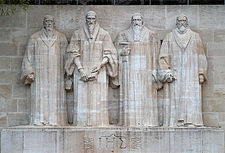Institutes of the Christian Religion
| Part of a series on |
| Reformed Christianity |
|---|
 |
|
|
Institutes of the Christian Religion is John Calvin's seminal work on Protestant theology.
The Book's Title
In English, this work is known as Institutes of the Christian Religion or Calvin's Institutes. This title, however, is not the best and most clear way to translate the actual title from the Latin. In the original Latin, the title of this work is Institutio Christianae Religionis. The Latin word institutio can mean arrangement, custom, introduction, education, or in the plural, principles of education. In the title of this work, the word institutio is singular. The English word institute can mean elementary principle or a brief, intensive course of instruction devoted to technical fields. But because of the way this word is used in the title, perhaps a better rendering would be introduction or catechism. This is supported by something Calvin himself says in his prefatory address to King Francis: "My intention was only to furnish a kind of rudiments, by which those who feel some interest in religion might be trained to true godliness." The latter part of the title, Christianae Religionis, is correctly translated as of the Christian Religion. So, all of this taken into consideration, a more helpful English title would probably be something like Introduction of (to) the Christian Religion or Catechism of the Christian Religion. However, the current English title has been in use for so long that it will probably never be replaced with a different rendering of the title.
Date and Purpose
The original Latin edition appeared in 1536 with a preface addressed to King Francis I of France, written on behalf of the French Protestants (Huguenots) who were being persecuted. Most often, references to the Institutes are to Calvin's final Latin edition of 1559, which was significantly expanded and revised from earlier editions. The Institutes are a primary historical reference for the system of doctrine adopted by the Reformed churches, usually called Calvinism.
Plan of the Book
The opening chapter of the Institutes is perhaps the best known, in which Calvin presents the basic plan of the book. There are two general subjects to be examined: the creator, and his creatures. Above all, the book concerns the knowledge of God the Creator; but "as it is in the creation of man that the divine perfections are best displayed", there also is an examination of what can be known about humankind. After all, it is mankind's knowledge of God and of what he requires of his creatures, that is overall the issue of concern for a book of theology. In the first chapter, these two issues are considered together, to show what God has to do with mankind (and other creatures), and especially, how knowing God is connected with human knowledge.
To pursue that explanation of the relationship between God and man, Calvin adopts a traditional structure of Christian instruction used in Western Christianity, by arranging the material according to the plan of the Apostles' Creed. First the knowledge of God is considered as knowledge of the Father, the creator, provider and sustainer. Then it is examined how the Son reveals the Father, as only God is able to reveal God. And finally, the third section of the Institutes describes the work of the Holy Spirit, who raised Christ from the dead, and who comes from the Father and the Son to affect a union in the Church through faith in Jesus Christ, with God, forever.
History of Revisions
The original Institutes were written in Latin. Calvin wrote five major Latin editions in his lifetime (1536, 1539, 1543, 1550, and 1559). He translated the first French edition of the Institutes in 1541, corresponding to his 1539 Latin edition, and supervised the translation of 3 later French translations. The French translations of Calvin's Institutes helped to shape the French language for generations, not unlike the influence of the King James Version for the English language. The final edition of the Institutes is about five times the length of the first edition.
In English, four complete English translations have been published. The first was made in Calvin's lifetime (1561) by Thomas Norton, the son-in-law of the English Reformer Thomas Cranmer. In the nineteenth century there were two translations; one by John Allen (1813) and one by Henry Beveridge (1845). The most recent is the 1960 edition, translated by Ford Lewis Battles and edited by John T. McNeill, currently considered the most authoritative edition by scholars. Due to the length of the Institutes, several abridged versions have been made. The most recent is by Tony Lane and Hilary Osborne; the text is their own alteration and abridgement of the Beveridge translation.
The best history of the Latin, French, and English versions of Calvin's Institutes was done by B. B. Warfield, "On the Literary History of Calvin's Institutes," published in the seventh American edition of the John Allen translation (Philadelphia, 1936).
This section needs expansion. You can help by adding to it. |
